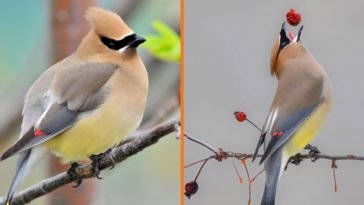Covered in a yellow, brown and grey plumage with a black and white eye mask and beak, this bird is not easy to miss
They are named ‘waxwings’ due to the bright red colored wax-like wing tips.

Native to North and Central America, these medium sized birds are often seen in winter gathering by the hundreds in trees eating berries.

In Summer, you are more likley to catch them making the most of their impressive aeronautical skills by hunting insects over the rivers.

Cedar waxwings stretch up to 7 inches long and weigh around 30g, making them smaller than most of their waxwing relatives.

Cedar waxwings are technically songbirds, although they don’t actually have a song, instead they make a few call notes.

You are likley to hear a flock of them using their high-pitched whistle/trill together before you ever even see one.

These birds are one of few that can survive for several months on a diet of fruit alone.

Often, they will eat so much honeysuckle berries, that their tail feathers will change color from yellow to orange.

They sometimes even become intoxicated by eating an overripe berry that began to ferment into alcohol.
The females are the nest builders, taking up to 6 days and requiring up to 2,500 trips to collect materials needed.
Although some are known to cut corners by stealing materials from other nests already built by other bird species such as rabins and yellow warblers.
Cedar waxwings are relatively common in North America, so if you’d like to attract some to your yard, fruit trees would be a good idea.
Often found in open areas or the edges of woodland area, especially if it is close to water and berry trees and bushes.
The sound of running water attracts the cedar waxwings, they enjoy bathing in shallow creeks while having a drink.
Found in pairs during mating season, but otherwise they are usually seen in large flocks numbering hundreds of them.












